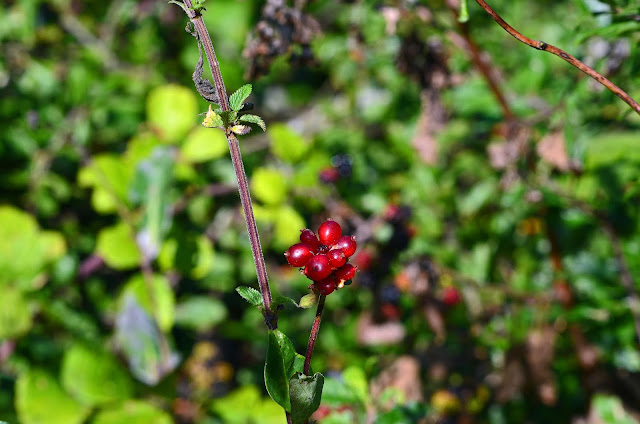Date: 27th August 2020
Time: from 9:15 a.m.
Weather: dry, sunny with increasing cloud, light wind, 15°C to 17°C
This was my first visit to the site during the day since 12th August 2020 due to following the Virtual Birdfair, some unseasonally wet and windy August weather and some other personal commitments.
However,
with the strong winds eventually subsiding and having checked the weather
forecast last night, I decided that a visit was long overdue given the dry and
sunny morning.
What
was immediately evident compared with my last visit 2 weeks ago was that many
of the wild flowers have died and have been replaced by the variety of autumn fruits,
berries and nuts.
Some
wild flower species were still obvious, most notably Common Knapweed and Common
Yarrow, but it was the blackberries (Bramble), haws (Hawthorn), hips
(Wild Rose), sloes (Blackthorn), elderberries (Elder), Honeysuckle and Holly plus the acorns (Oak) and
conkers (Horse Chestnut) that were most evident.
The
reduced diversity and abundance of wild flowers has led to an decline in
butterfly species although I still managed to record 4 species: Holly Blue
(2), Small Copper (1), Small White (3), Gatekeeper (5 to
10)
With regard to birds, it continues to be exceptionally quiet with
few birds seen and only sporadic singing and calling. However, the increase in Robin
song was very noticeable which is not surprising since this species is usually
the first to return to singing after the breeding season and summer moult is over.
A momentary lapse led me to believe that I heard a Swift (which
would have been a late record since this summer visitor has largely disappeared
now and migrated south for the winter) but then I realised it was the distinctive, repetitive, high-pitched begging call of
a juvenile Herring Gull. Sure enough, an adult Herring Gull appeared
overhead pursued by 2 juveniles.
Speaking of summer visitors, I thought that
this visit would fail to provide any sightings or singing/calling records from
both Blackcaps and Chiffchaffs but
towards the end of my visit I did hear an alarm calling Blackcap from the
wooded area at the top of Church Hill.
I saw a single Great Spotted Woodpecker in the cemetery plus I heard a single calling Green
Woodpecker around the top of Church Hill.
Like my last visit, I saw 3 individual Grey
Squirrels, the first along the entrance track to the site from Larkins
Tyres, a second at the eastern edge of the cemetery and a third along the
woodland track approaching my flat.
Species recorded during this visit were as follows (heard only records in italics):
Blackcap
Blue Tit
Great Tit
Long-tailed Tit
Dunnock
Robin
Blackbird
Green Woodpecker
Great Spotted Woodpecker
Magpie
Carrion Crow
Woodpigeon
Collared Dove
Herring Gull
Grey Squirrel
Holly Blue
Small Copper
Small White
Gatekeeper
Here are some photos from my visit:

Photo: St. Nicholas Church

Photo: Small Copper
Photo: record shot of Great Spotted Woodpecker
Photo: Common Knapweed

Photo: Common Knapweed
Photo: Common Yarrow
Photo: Blackberries
Photo: Blackberries
Photo: Blackberries
Photo: Haws
Photo: Haws
Photo: Haws
Photo: Haws
Photo: Haws
Photo: Haws
Photo: Hips
Photo: Hips
Photo: Hips

Photo: Sloes
Photo: Sloes
Photo: Sloes
Photo: Sloes
Photo: Elderberries
Photo: Honeysuckle
Photo: Honeysuckle
Photo: Holly
Photo: Acorn
Photo: Acorns
Photo: Acorns
Photo: Horse Chestnut conkers
Photo: Horse Chestnut conker
Photo: Horse Chestnut conkers
Photo: Horse Chestnut conkers
Site totals to date:
Birds = 49
Mammals = 6
Butterflies = 20
Dragonflies and damselflies = 6
Reptiles = 1
Amphibians = 0
💚🦆 🦉🦋🐝🦊🦡🌼 🌳💚
Stay safe, stay well, stay strong, stay connected with nature





























No comments:
Post a Comment
If you feel like commenting on my blog, you can contact me by completing the comment form below. I will respond to all comments and enquiries and constructive criticism will always be welcomed.